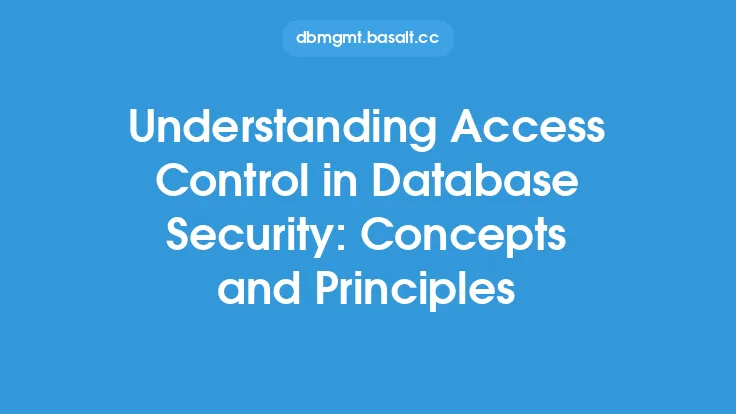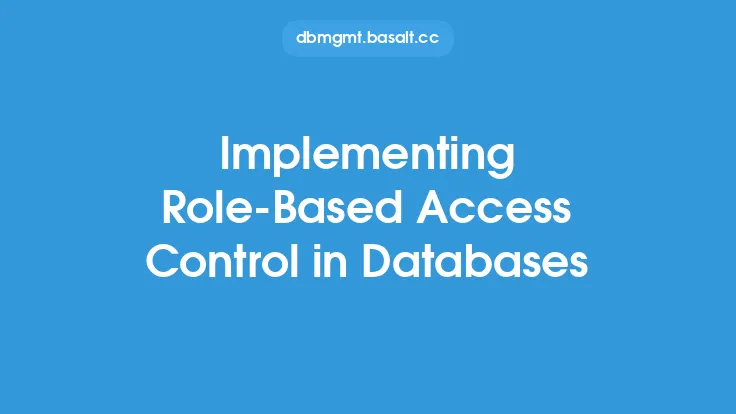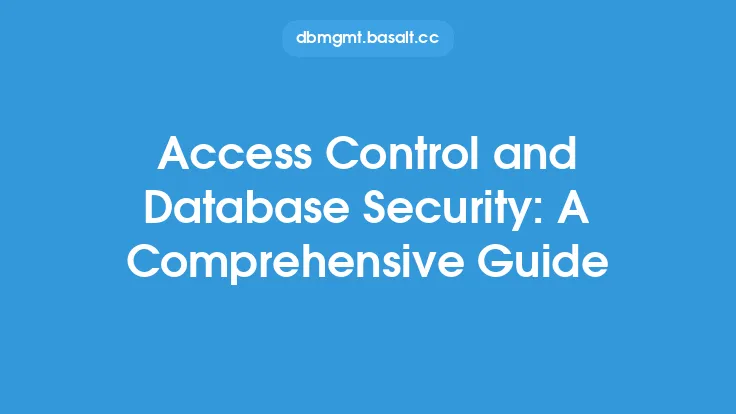Access control is a critical component of database security, as it ensures that sensitive data is protected from unauthorized access, use, or disclosure. There are several access control models that can be used to regulate access to database resources, including discretionary, mandatory, and role-based models. Each of these models has its own strengths and weaknesses, and the choice of which one to use depends on the specific security requirements of the database.
Discretionary Access Control (DAC)
Discretionary access control (DAC) is a model that grants access to database resources based on the discretion of the owner of the resource. In a DAC model, the owner of a resource, such as a table or a view, has the ability to grant or deny access to other users. The owner can specify the level of access that each user has, such as read-only, read-write, or execute. DAC models are commonly used in databases where the owner of the resource has a high degree of control over who can access the resource.
In a DAC model, access control is typically implemented using access control lists (ACLs). An ACL is a list of users or groups that have been granted access to a resource, along with the level of access that each user or group has. For example, an ACL for a table might specify that user "John" has read-write access, while user "Jane" has read-only access.
Mandatory Access Control (MAC)
Mandatory access control (MAC) is a model that grants access to database resources based on a set of rules that are defined by the system administrator. In a MAC model, access control is based on the sensitivity level of the resource and the clearance level of the user. The sensitivity level of a resource is a measure of how sensitive the resource is, while the clearance level of a user is a measure of how trustworthy the user is.
In a MAC model, access control is typically implemented using a lattice-based approach. A lattice is a mathematical structure that represents the relationships between different sensitivity levels and clearance levels. The lattice defines the rules for accessing resources, such as "a user with a clearance level of 'secret' can access resources with a sensitivity level of 'secret' or lower".
MAC models are commonly used in databases where the security requirements are very high, such as in military or government databases. MAC models provide a high degree of security, but they can be complex to implement and manage.
Role-Based Access Control (RBAC)
Role-based access control (RBAC) is a model that grants access to database resources based on the role that a user plays within an organization. In an RBAC model, users are assigned to roles, and each role has a set of permissions associated with it. The permissions define what actions a user can perform on a resource, such as read, write, or execute.
In an RBAC model, access control is typically implemented using a role hierarchy. A role hierarchy is a structure that defines the relationships between different roles, such as "a manager is a subset of an employee". The role hierarchy defines the rules for accessing resources, such as "a manager can access all resources that an employee can access, plus additional resources".
RBAC models are commonly used in databases where the security requirements are moderate to high, such as in commercial databases. RBAC models provide a good balance between security and usability, and they are relatively easy to implement and manage.
Comparison of Access Control Models
Each of the access control models has its own strengths and weaknesses. DAC models provide a high degree of flexibility, but they can be complex to manage and may not provide adequate security. MAC models provide a high degree of security, but they can be complex to implement and manage. RBAC models provide a good balance between security and usability, but they may not provide adequate flexibility.
The choice of which access control model to use depends on the specific security requirements of the database. If the security requirements are very high, a MAC model may be the best choice. If the security requirements are moderate to high, an RBAC model may be the best choice. If the security requirements are low, a DAC model may be the best choice.
Implementation Considerations
Implementing an access control model in a database requires careful consideration of several factors, including the security requirements of the database, the complexity of the model, and the usability of the model. The following are some implementation considerations to keep in mind:
- Security requirements: The access control model should be designed to meet the security requirements of the database. This includes considering the sensitivity level of the resources, the clearance level of the users, and the level of access that each user should have.
- Complexity: The access control model should be designed to be as simple as possible, while still meeting the security requirements of the database. Complex models can be difficult to implement and manage.
- Usability: The access control model should be designed to be usable by the users of the database. This includes providing a user-friendly interface for managing access control, and providing adequate documentation and training for the users.
- Scalability: The access control model should be designed to be scalable, so that it can handle a large number of users and resources.
- Performance: The access control model should be designed to have minimal impact on the performance of the database.
Conclusion
Access control models are a critical component of database security, as they ensure that sensitive data is protected from unauthorized access, use, or disclosure. There are several access control models that can be used, including discretionary, mandatory, and role-based models. Each of these models has its own strengths and weaknesses, and the choice of which one to use depends on the specific security requirements of the database. By carefully considering the implementation considerations, database administrators can design and implement an access control model that meets the security requirements of the database, while also providing a good balance between security and usability.





